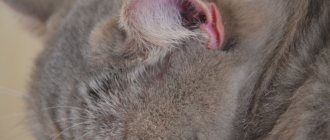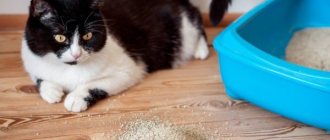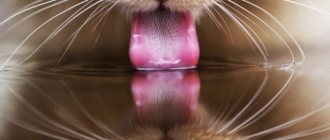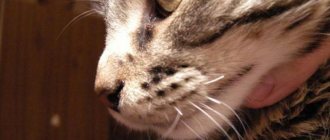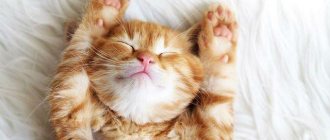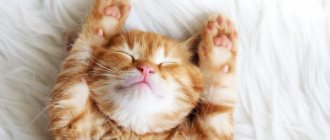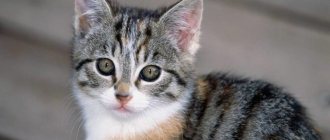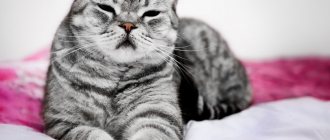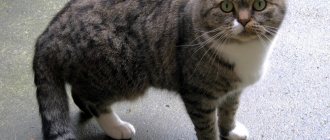A dry nose in a cat is considered a sign of pathology. Just like with domestic dogs, cat owners determine their health status by the dryness of the nasal planum. In fact, there are much more factors that provoke dry nose in a cat, and not all of them are pathological. An example of this is the presence of an animal for a long time near heating devices or in the sun. The humidity of the nasal planum can change several times throughout the day.
It is necessary to understand in which cases a dry nose is part of the norm, and in which cases it is necessary to sound the alarm and contact a veterinarian for help.
What should a cat's nose be like?
A healthy animal has a moist, slightly slippery nose. This physiological state is ensured by regular licking of the tongue and the release of a specific secretion that performs a protective function.
For a domestic cat, the nose is not just an organ for sensing smells. Your pet's nose works as an indicator, allowing you to determine the direction of air flow and the temperature of nearby objects. A wet spout works better, but when the surface dries out, some functions begin to decline or are completely lost.
In small kittens, the nasal planum is not always wet. This is due to the fact that babies are not yet able to lick their lips, and the cells of the mucous membrane do not produce enough secretions.
When is it normal for a cat to have a dry nose?
The correct functioning of the olfactory organ is extremely important. In addition to detecting certain aromas, a cat needs a wet nose to recognize the direction of air currents. The animal needs this in order to clearly identify the source of the aroma or to carefully hide from the victim. The dried mucous membrane begins to lose its direct functions.
On the surface of the nose, there are a number of specific glands that produce a mucous secretion that protects the membranes from drying out. To maintain moisture, cats constantly lick the nasal planum. If an animal is hot, it begins to lick its nose more often, lowering its body temperature due to the evaporation of moisture. Dry nose under normal conditions can occur in a cat:
- immediately after waking up or during sleep;
- when exposed to the sun for a long time or near heating devices;
- when the animal experiences severe stress;
- after active games.
After slight overheating in the sun or after active games, the body temperature returns to normal without outside intervention completely independently. Also, the cat does not lick its nose during sleep, so it may wake up with a dry surface of the nasal planum.
Loss of moisture also occurs when the nasal passages are clogged with dirt and dust. If there are no other signs, you should try to examine your pet, paying attention to the nasal passages. If necessary, you can try to clear your sinuses.
An owner who notices a dry nose in their pet should check the temperature of the ears. An increase in temperature throughout the body, characterized by a change in temperature in the ears. In small kittens, thermoregulation processes differ from adult animals. Therefore, a dry and warm nose in a small kitten is often a variant of the norm.
A dry nose in a cat that has recently given birth is also considered normal. Gradually, all organs will begin to return to normal, the animal’s condition will stabilize, and the nose will become moist again. In this case, the help of a veterinarian is not needed.
Pathological causes of a dry nose in a cat
When exposed to natural causes, a cat's warm and dry nose does not last long. After a few minutes or hours, the outer part of the olfactory organ becomes moist and cool. But it also happens that the pet’s condition does not stabilize, the nose remains warm or even hot. In addition to changes in nasal temperature, a cat experiences a number of other signs indicating the development of a pathological process:
- apathetic states and lethargy;
- loss of appetite or complete refusal to eat;
- long and continuous sleep;
- heart rhythm problems;
- polydipsia (increased thirst);
- respiratory dysfunction - shortness of breath;
- discharge from the nasal passages and eyes;
- restless behavior;
- stool and digestive disorders, manifested by attacks of nausea, vomiting and diarrhea.
The appearance of the above symptoms directly indicate the development of a pathological process. A dry nose in this case is only one of the components of the overall clinical picture.
In addition to the condition of the mucous membrane, or rather its moisture content, it is also necessary to note a change in shade. A cat's nose that is pale and warm to the touch is most often a sign of the development of pathological processes in the cardiovascular system. The bright pink color of the nasal planum, which is not typical for a cat in its normal state, indicates the development of infectious lesions. A bluish color more often indicates problems in the respiratory system (lack of oxygen, inflammation in the pulmonary structures and intoxication). A yellowish tint to the cat's nose indicates problems with the liver.
Only a veterinarian has the right to make an accurate diagnosis, much less prescribe an adequate treatment regimen. In addition to the examination, the specialist must conduct a number of studies to determine the exact cause of the disturbances in the patient’s body condition. The most common causes of inflammation and subsequent rise in body temperature are:
- formation of stones in the urinary system;
- dehydration due to illness;
- inflammation in the digestive tract;
- viral infections;
- intoxication.
Danger signs
If your cat has signs of a skin disease, such as crusts or cracks on the nose, this is a signal to visit a veterinarian. Watery eyes, dry nose and throat - this indicates the development of a virus in the body or an allergy. When vomiting or diarrhea occurs against a background of high fever, there may be signs of infection.
If a cat has no appetite, he has stopped drinking and his fur has become dull, then this condition means that he is dehydrated, and the functioning of the animal’s mucous membranes is disrupted, which leads to a dry nose. The cat has a hot nose, has lost its appetite, hides, lies lethargic and sleeps a lot, this behavior indicates stress. Hyperactivity accompanied by irritability indicates neurosis due to lack of sleep. When, after pregnancy, an animal feels weak and its nose is dry, this indicates dehydration. A neutered cat's fever does not subside for more than 3 days; the help of a specialist is needed.
First aid if your cat has a dry nose
A hot and dry nose in a pet is not a reason to panic if it is caused by natural causes and goes away on its own. But if such a symptom persists for several hours with a clear deterioration in the general condition, it is recommended to seek help from a veterinary hospital. Helping a cat at home is problematic, since it is practically impossible to reliably identify the factors influencing the development of deterioration of the condition.
Self-prescribing medications to your pet without first consulting a doctor often leads to dire consequences.
Thus, self-administration of antipyretic drugs, such as Paracetamol or acetylsalicylic acid, leads to dangerous complications in the body.
If you cannot immediately seek help from a veterinary clinic, you can try to provide first aid at home. The biggest danger with an increase in body temperature, manifested by a dry nose, is the development of dehydration. The cat must be given the opportunity to drink more, preferably cool water. A cat that refuses to drink water on its own should be given water from a syringe with the needle removed or a pipette.
Animals that do not have fur can be wiped with a damp, cool towel or napkin. A long-haired cat can be helped by sprinkling its fur with water from a spray bottle.
If your pet's body temperature is over 39.5 degrees, you should try to bring it down with cold compresses. A small bag of ice wrapped in a cloth is applied to the groin area and head. It is prohibited to carry out such manipulations for a long time.
What to do if the temperature is elevated and there are other alarming symptoms
Do cats fart: the main reasons and is it normal?
You should never try to give your pet human medications. Paracetamol, which is given to people in similar circumstances, is extremely toxic to cats, as are many other drugs. The body is fighting the disease, and intervention without a clear understanding of the problem will only cause harm.
Help from the owner may be needed to restrain a restless cat.
You also don't need to wipe your cat's nose with a tissue to make it look important or to wipe away secretions. This can cause an allergic reaction, especially if alcohol or other antiseptic comes into contact with the mucous membrane. An alternative option is a cloth moistened with plain water. She will remove everything unnecessary.
It is necessary to provide the patient with peace, put water nearby. You can dampen the coat if the temperature is too high. You should definitely call a veterinarian or go to the clinic with your furry patient. When the animal is not in critical condition, the second option is preferable: calling a good specialist to your home is expensive, but if you save money, there is a chance to meet with a non-professional. In extreme cases, when there is no opportunity to meet with a doctor in person, a call with a description of the problem will help. General recommendations can also be obtained remotely.
Note! It is better to film the symptoms of the disease: in an unfamiliar environment or with a stranger, the animal will become nervous, and its behavior may change.
When transporting, you need to check the cat's condition more often, even if he did not look very sick. Many doctors require patients to wear carriers; a gym bag will do as long as it has holes for ventilation. The cat will be calmer if he can look around. But it is not safe to carry it in your hands, because the slightest fright and it will break out.
Just in case, you need to stock up on water and a bowl to avoid dehydration due to overheating. If possible, stress should be kept to a minimum so as not to weaken an already sick animal.
It is better for the owner to stay with the pet in the office. Man's furry friend will be worse off alone among strangers and unfamiliar smells.
Dry nose is not always a disease
The most important thing to remember is that a dry cat's nose is not always a disease. It is necessary to assess the condition of the animal as a whole, including its behavior. If you suspect a serious illness, you should never treat your pet with human medications, so as not to cause even more harm. A visit to the clinic will not be unnecessary. It is much worse not to take a sick cat there than to mistakenly show a healthy one to the doctor.
When to contact a veterinarian
As soon as first aid is provided, you need to seek help from a specialist. It is important to identify the source of the disease, and only a qualified veterinarian can do this. In addition to a dry and hot nose, as the pathological process develops, the following signs develop that require contacting a veterinary clinic:
- Loss of appetite or complete refusal to feed. A weakened animal loses interest in food. Most often, such changes occur during serious infections, inflammatory processes and exacerbations of chronic diseases. Perhaps the cat has lost its appetite due to stress and a dry nose combined with loss of appetite is proof of this. In order to ensure the absence of an inflammatory process, it is necessary to measure body temperature rectally.
- Changes in body temperature in the ear area. Hot ears and a warm nose are a sign of hyperthermia. The cause of this condition may be the presence of ear mites, infectious lesions of the ear canal, the presence of viral infections, hematomas and other mechanical damage to the ear.
- Changing the shade of the nasal planum. A reason to immediately contact a veterinarian for help is a change in the color of the nose. A purple or bluish tint is often evidence of poisoning of the body or disturbances in the functioning of the cardiovascular system. A yellowish tint to the nose indicates liver disease, while a red or bright pink color is often a sign of a viral infection.
- Digestive disorders. Abdominal pain, attacks of nausea and eruption of gastric contents, diarrhea - all these are signs of serious disturbances in the functioning of the body and require contacting a clinic. It is especially important to react quickly if blood appears in your cat’s stool. Most often this is a sign of damage to internal organs.
- Breathing problems, weight loss, seizures. A dry nose can be one of the symptoms of serious disorders in the body. The cause of such signs may be malignant neoplasms or problems in the functioning of the central nervous system. You cannot do without the help of a veterinarian.
Temperature measurement
Only a veterinarian can find out the exact reason why a cat has a warm or hot nose. However, such trips can cause unnecessary stress for the animal. In order not to disturb your pet once again, you can measure the temperature yourself and find out if there is really a reason for concern.
The temperature in animals is determined rectally or through the anus. The thermometer can be pre-lubricated with oil or Vaseline. It is recommended to use a plastic (it is the most durable) or electronic thermometer to get faster results.
There are also infrared thermometers that are designed to measure ear temperature. Normally, a cat’s temperature ranges from 37°-39°. If it is above 39 degrees and is accompanied by symptoms of malaise, then the help of a veterinarian will be required.
ATTENTION! Self-prescription of treatment is not allowed, since ignorance of the exact diagnosis can aggravate the cat’s condition.
Activities in the veterinary clinic
A hot and dry nose in a cat that does not return to normal after several hours is most often evidence of serious pathologies. The first actions of a doctor if a cat owner approaches with symptoms of hyperthermia are:
- general clinical examination;
- measuring body temperature;
- taking anamnesis;
- collection of blood and urine tests.
Neoplasms of a benign and malignant nature in the nasal sinuses, serious mechanical damage (for example, a foreign body), chronic rhinitis and viral infections can provoke the appearance of dry nasal planum in a pet. Often, breathing problems occur in cats due to helminthiases, digestive disorders and trichobezoars (hairballs) formed in the stomach or intestines.
Depending on the identified pathology that provoked an increase in temperature and dryness of the nasal planum, treatment is prescribed. This can be a whole range of therapeutic measures aimed not only at eliminating the main factor, but also symptomatic treatment that eliminates signs of pathology.
Symptoms of pathology and diagnostic methods
During the day, the nose constantly changes from dry to wet and vice versa, this is considered the norm, because everything depends on the lifestyle and mobility of the animal. You also need to know that the temperature of a cat’s nose is 2 °C higher than that of a human, so it may seem that the cat’s nose is hot, but it is not. When there is lethargy throughout the day and a constantly elevated temperature, above 39.5 °C, it is worth taking your pet to a veterinarian and taking a blood test to determine the infection.
A consultation will be needed if the cat's nose color has changed. There are cat breeds whose earlobe color changes depending on the season, and older animals may develop pigmentation. When the nose becomes dry and cracks, this is dry nose syndrome, which affects cats of the Bengal breed. If your pet has a cold, chills, poisoning, shock, a cold and dry nose will be observed. Yellow indicates liver or kidney disease, and an inflamed red organ of smell is a sign of:
- rhinitis;
- infections;
- mechanical irritation;
- high blood pressure;
- high temperature;
- allergies.
If the olfactory organ is hot, you need to contact a specialist who will conduct an examination and identify the cause of the disease.
When a cat has a hot nose for a long time, it is necessary to analyze the clinical picture as a whole. The doctor will conduct a comprehensive examination, measure the temperature, take the necessary blood tests, perform an ultrasound if necessary, and then prescribe treatment. During the examination of the animal, the veterinarian pays attention to the condition of the pet:
- Is the lobe covered with crusts?
- dirty nose, discharge from the nostrils;
- behavior;
- appetite and drinking water;
- reaction to external stimuli.
